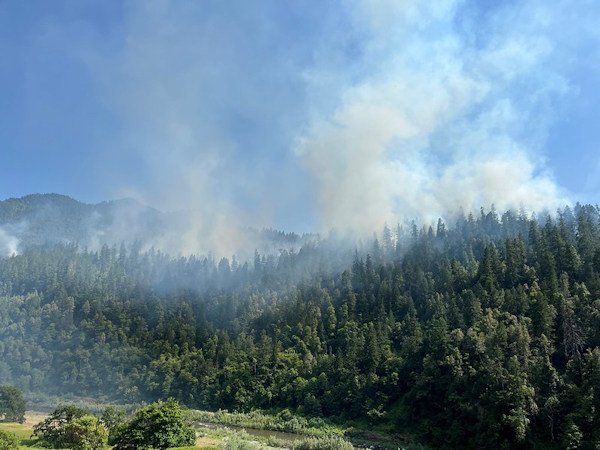OSU researchers’ project shows Indigenous stewardship’s role in forest ecosystem resilience

CORVALLIS, Ore. (KTVZ) – Oregon State University researchers have teamed with the Karuk Tribe of Northern California to create a novel computer simulation model that showcases Indigenous fire stewardship’s role in forest ecosystem health.
Western scientists and land managers have become increasingly cognizant of cultural burning but its extent and purpose are generally absent from fire modeling research, said Skye Greenler, who led the partnership when she was a graduate research fellow in the OSU College of Forestry.
“We developed this project in collaboration with the Karuk Tribe to explore the impact of cultural burning at a landscape scale in a completely new way,” she said. “The information that went into this model is not new at all – it’s been held by Karuk Tribal members for millennia – but we developed new methods to bring the knowledge together and display it in a way that showcases the extent of Indigenous cultural stewardship across this landscape.”
Greenler and collaborators including Chris Dunn and John Bailey of Oregon State say that understanding the interactions among humans, fire processes and pathways towards coexistence with wildfire has become increasingly urgent as the social, ecological and economic impacts of fire have intensified in recent years.
The research focused on 1,000 square miles of Karuk Aboriginal Territory in the western Klamath Mountains of northern California. Working with the Karuk Tribe Department of Natural Resources, OSU scientists developed historical estimates for cultural ignition locations, frequency and timing. Statistical parameters were collaboratively developed and honed with Tribal members and knowledge holders using interviews, historical and contemporary maps, ethnographies, recent ecological studies and generational knowledge.
Published in Ecological Applications, the findings show that before the arrival of European colonizers, cultural burning was extensive across the landscape, with an estimated 6,972 cultural ignitions occurring annually, averaging about 6.5 ignitions per year for each Indigenous fire steward.
The researchers, who included scientists from the University of Washington, the Mid-Klamath Watershed Council, and the U.S. Forest Service’s Pacific Northwest and Pacific Southwest research stations, found that the timing and location of burning was often guided by the ecology of specific cultural resources, fuel receptivity, seasonal movement patterns and spiritual practices.
“The ignition characteristics we document align closely with data on historical fire regimes and vegetation but differ substantially from the location and timing of the ignitions happening now,” Greenler said. “This work shows the importance of cultural burning for developing and maintaining the ecosystems present at the time of colonization and underscores the need to work collaboratively with Indigenous communities to restore ecocultural processes.”
Northern California’s western Klamath Mountains are a diverse and highly fire- prone ecosystem that historically burned frequently at low or moderate severity but have recently experienced many extensive or severe wildfires, the researchers point out.
“Collaboratively integrating western and Indigenous fire science and knowledge systems in this research will help reinstate fire on this landscape to achieve socioecological resource values with benefits both to tribes and the public,” said the Forest Service’s Frank Lake, a Karuk Tribal descendant who earned a doctorate from the OSU College of Forestry.
The study area is one of many fire-prone landscapes in the western United States that have a long history of cultural burning, defined as the purposeful use of fire by an Indigenous group to promote food, medicinal and material resources. Cultural burning also alters wildfire risk and how fires spread.
“It would be incredible to go back in time and experience the study landscape with open oak groves, hillsides of high quality and abundant first foods, frequent, small cultural burns in the mornings or late afternoons, and little fear of large wildfires when dry lightning storms passed over the mountains in August,” Greenler said. “A recent shift within western scientific and management communities is towards a greater interest in supporting Indigenous fire stewardship practices that better balance relationships between people and fire.”
The increased interest follows decades of work from Indigenous communities to assert sovereign rights to land stewardship, emphasize the importance of cultural burning and build collaborative relationships and policies that integrate cultural burning into research, management and restoration practices, the scientists say.
“The lens with which scientists view data in observational scientific studies affects their interpretation of the results,” Dunn said. “As our acceptance of Indigenous Knowledge grows, we are experiencing a shift in our interpretation of fire regimes, ecological outcomes and humans in these systems. This does not invalidate previous studies but builds upon them for a more accurate understanding of history, and with that, where we are going in the future.”
Indigenous fire stewardship is deeply place-based, Greenler said, meaning the collaborators’ findings are not directly transferable to other landscapes, but the process that was used to develop and model estimates of cultural ignitions could “absolutely be applied” in other landscapes to better understand the impacts and patterns of cultural burning.
“It was a real pleasure to work on this project,” said Bill Tripp, director of natural resources and environmental policy for the Karuk Tribe. “Being able to incorporate Karuk Indigenous Knowledge, practice and belief systems into a product that can help assess historic fire regimes in a way that protects our proprietary information and locational data in regard to the site-specific resources we are working to enhance is of vital importance to our ecocultural revitalization efforts.”
Greenler stresses the importance of remembering that cultural burning remains an important practice on many landscapes today, including in northern California. She would like the collaboration with the Karuk Tribe to help provide information for society to use in restoring balanced human-fire relationships – which in some ways may emulate historical practices and in other ways may not, she said.
“I hope for all of us that we can continue to learn from Indigenous communities, uplift Indigenous Knowledge and sovereignty, and work towards a future where we can better co-exist with fire on our landscapes,” Greenler said.